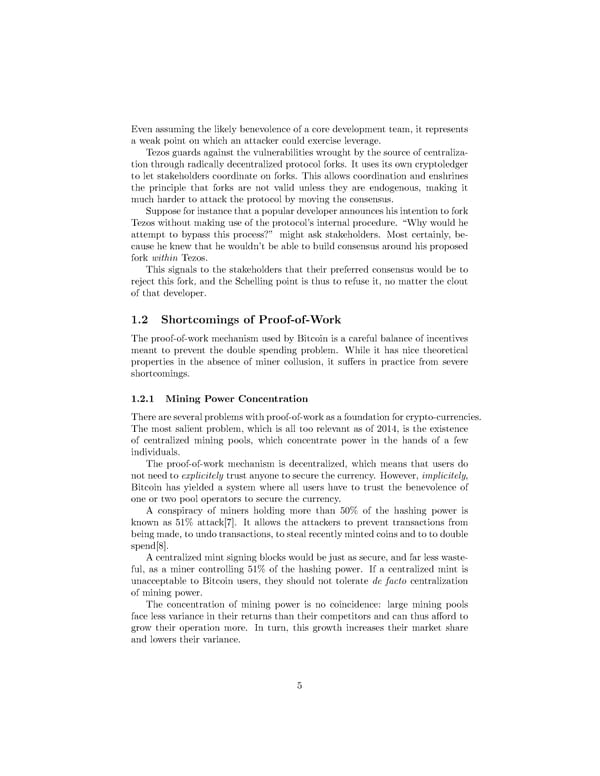Even assuming the likely benevolence of a core development team, it represents a weak point on which an attacker could exercise leverage. Tezos guards against the vulnerabilities wrought by the source of centraliza- tion through radically decentralized protocol forks. It uses its own cryptoledger to let stakeholders coordinate on forks. This allows coordination and enshrines the principle that forks are not valid unless they are endogenous, making it much harder to attack the protocol by moving the consensus. Supposeforinstancethatapopulardeveloperannounceshisintentiontofork Tezos without making use of the protocol’s internal procedure. “Why would he attempt to bypass this process?” might ask stakeholders. Most certainly, be- cause he knew that he wouldn’t be able to build consensus around his proposed fork within Tezos. This signals to the stakeholders that their preferred consensus would be to reject this fork, and the Schelling point is thus to refuse it, no matter the clout of that developer. 1.2 Shortcomings of Proof-of-Work The proof-of-work mechanism used by Bitcoin is a careful balance of incentives meant to prevent the double spending problem. While it has nice theoretical properties in the absence of miner collusion, it suffers in practice from severe shortcomings. 1.2.1 Mining Power Concentration Thereareseveralproblemswithproof-of-workasafoundationforcrypto-currencies. The most salient problem, which is all too relevant as of 2014, is the existence of centralized mining pools, which concentrate power in the hands of a few individuals. The proof-of-work mechanism is decentralized, which means that users do not need to explicitely trust anyone to secure the currency. However, implicitely, Bitcoin has yielded a system where all users have to trust the benevolence of one or two pool operators to secure the currency. A conspiracy of miners holding more than 50% of the hashing power is known as 51% attack[7]. It allows the attackers to prevent transactions from beingmade,toundotransactions, tostealrecentlymintedcoinsandtotodouble spend[8]. Acentralized mint signing blocks would be just as secure, and far less waste- ful, as a miner controlling 51% of the hashing power. If a centralized mint is unacceptable to Bitcoin users, they should not tolerate de facto centralization of mining power. The concentration of mining power is no coincidence: large mining pools face less variance in their returns than their competitors and can thus afford to grow their operation more. In turn, this growth increases their market share and lowers their variance. 5
 A Self-Amending Crypto-Ledger Position Paper Page 6 Page 8
A Self-Amending Crypto-Ledger Position Paper Page 6 Page 8